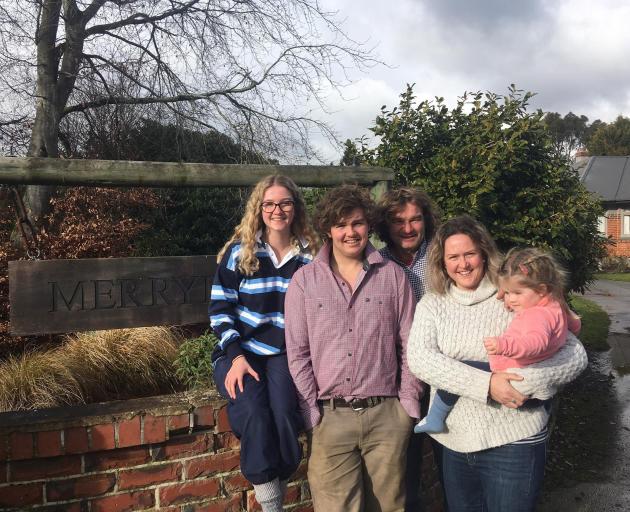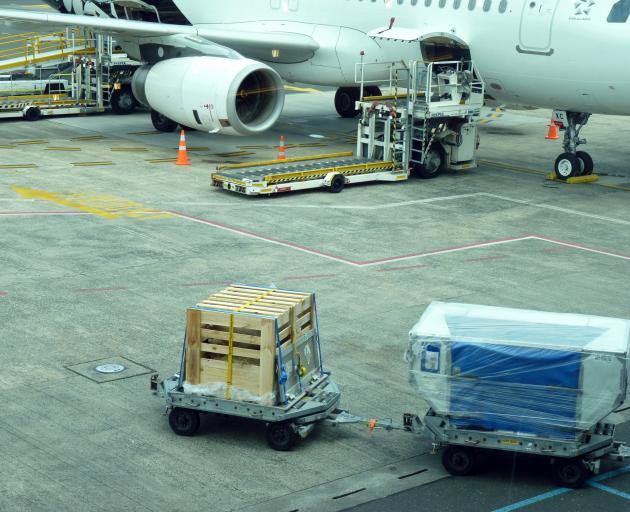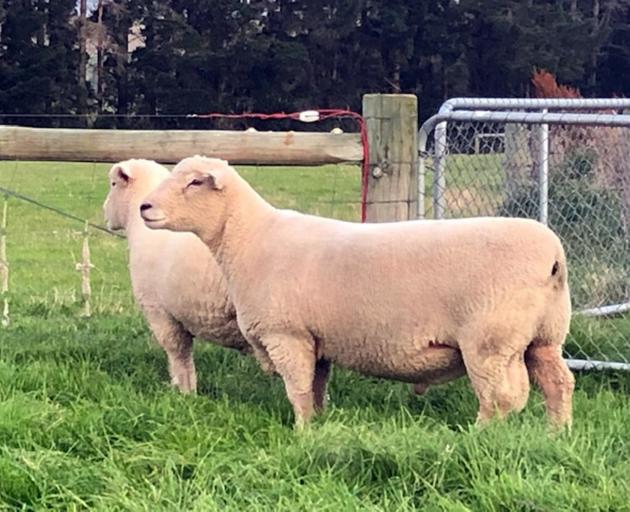By Sally Rae

Jess (18), Jack (17), Blair and Sally (holding Stella, who is nearly 3) Robertson, at home at the Merrydowns stud in West Otago.
Back in January, some unusual cargo arrived on the tarmac at Dunedin Airport.
It was a Southdown ram, Kirkdale 36-18, which was flown on a passenger flight from Auckland, having previously made the trip over the Tasman from the Kirkdale stud in Tasmania.
The ram was bought by West Otago stud breeders Blair and Sally Robertson, of the Merrydowns stud, at Waikoikoi, who have the world’s largest Southdown stud.
Mr Robertson judged at a show in Geelong two years ago and was greatly impressed by the Kirkdale entries — Australia’s second-oldest Southdown stud, which was established in 1884 and is now run by fifth-generation Andrew Hogarth.
The team — from lambs to rams and ewes — was “awesome” and, while there, Mr Robertson offered to buy two of the rams, but the deal did not work out.

A Southdown ram, imported from Australia by Blair and Sally Robertson, arrives on the tarmac at Dunedin Airport in January.
He told Mr Hogarth to keep them in mind for next year and, when he rang him in September last year, Mr Hogarth sent him some videos, photographs and pedigrees, and he selected three rams.
Of those three, Mr Hogarth was keeping two for himself and offering the third at his on-farm sale. So Mr Robertson asked if he could buy 36 — one of his keeper rams — which he felt was the pick of them.
Initially reluctant, Mr Hogarth asked for a week to think about it before agreeing to sell the ram and Mr Robertson told him to put him “on the next plane from Melbourne”.
Kirkdale was not a big stud but Mr Hogarth was a “real stockman” who “thinks along the same lines as us”, Mr Robertson, a fourth-generation stud breeder, said.
The ram was the best he had seen since he paid $14,000 for a ram from Brent Macaulay’s Maclaka stud in 2014. It was sired by an Australian ram he liked, Mr Robertson said.
His latest acquisition had “a decent set of feet and legs to start with”, along with the basic commercial traits — good hindquarter, muscling, depth and spring of rib.
Despite not seeing the ram in the flesh until he arrived at the airport, Mr Robertson said he had seen enough from the videos and also from Mr Hogarth’s other sheep.
“I’m really visual — I see lots of things other people don’t see.”
It was first sheep to be flown into Dunedin for about 20 years, and it was a “bloody comical” scene when the crate was being unloaded.
Travelling had no effect on the ram.
“You wouldn’t have known he had been anywhere. He’s that sort of sheep — just a grunter.”
He put the ram out with 185 ewes and he marked them all and came out of the ewes “as good as he went in”.
He believed the ram was going to be good for the sheep industry, particularly Southdowns, giving a straight outcross with a pedigree that was all Australian blood.
With the Maclaka sire, the Merrydowns stud — which has more than 700 ewes — had Australian blood, so it was “like with like” and not just a random selection.
He was a very similar sheep to the Merrydowns sheep and that was the key to try to find something like that.
It was not often in a lifetime you saw a ram that could make a significant difference and, if you did, then you should buy it, he said.
He was looking forward to seeing how he bred and it was likely the stud would retain five or six sons.
The benefits of using Southdowns included early maturing and the early mean kill; all their commercial lambs were killed at 20kg before lockdown, meaning there was room either to feed the ewes more or buy cattle or store lambs.
But lockdown was a major problem for a lot of farmers who still had lambs on and could not get them killed, Mr Robertson said.
The early mean kill date was critical for large commercial operations to get as many lambs as possible off the ewe as soon as possible.
Southdowns were ideal for hogget mating — “if you go to the trouble of putting your hoggets in lamb, you might as well get a decent lamb” — while the ewes were also very efficient over the winter.
He and his wife — who also have a Romney stud with about 1000 ewes, plus commercial ewes — were passionate about the sheep industry and the breeding industry, he said.
For them, it had to be “a package” — “there’s got to be figures but there’s also got to be a sheep. You can’t have one without the other,” Mr Robertson said.
A lot of modern sheep breeds had never been tried and tested; Southdowns had been culled for generations for those commercial traits of muscling and early maturing, the same as the Romneys which had been culled for centuries for their traits, he said.
In the 1950s, there were about 1200 stud Southdown flocks in New Zealand but they went out of fashion later on; there were now about 63 flocks and they were growing in popularity. Australia had also seen a resurgence in interest.
He believed there was a better type of Southdown in Australia, one that was more traditional, with more spring of rib and sounder, Mr Robertson said.
The family — which includes daughters Jess (18) and Stella (nearly 3) and son Jack (17) — were also “bloody passionate” about wool and took pride in producing quality fibre. Their Romney ewes shore about 7.5kg.
But the state of the wool industry was a “bloody disaster” and he implored consumers to stick to natural fibres such as wool, silk and cotton, rather than using synthetic products.
There were generations of the urban population who knew nothing about wool and were not aware of the benefits of it; they needed to be educated about those benefits and synthetic products taken off the shelf. If people were genuinely interested in the environment, then they should be demanding natural fibres, Mr Robertson said.

